
Subscription Exit Strategies: Exploring the Customer Journey Through Cancellation
Executive Summary
The process of canceling a subscription is a critical touchpoint in the customer journey, often intentionally made challenging by companies. This report, based on a survey of 1,091 respondents, examines the complexities of subscription cancellations and reveals insights that significantly impact customer satisfaction and brand perception.
Key findings:
- Recent Cancellation Trends: 81.1% of respondents have canceled or attempted to cancel a subscription within the last six months, highlighting how common this experience is for customers.
- Customer Tenure: 40.7% of customers kept their subscriptions for over a year before canceling, emphasizing the importance of a smooth cancellation process in potentially regaining long-term customers.
- Primary Cancellation Drivers: Cost (63%) and lack of usage (57.8%) are the main reasons for cancellations, pointing to opportunities for flexible pricing and improved engagement strategies.
- Cancellation Experience: Only 23.6% of respondents rated the cancellation process as “Very easy,” while 28.9% found it “Somewhat Difficult” or “Very Difficult.” This indicates that many customers struggle with canceling subscriptions, highlighting a need for improvement in user experience.
- Common Challenges: 40.8% of respondents had trouble finding cancellation information, and 31.7% had to contact customer service, revealing friction points in the cancellation journey.
- Preferred Cancellation Methods: 68% prefer to cancel directly through the service provider’s website or app, underscoring the need for accessible, self-service options.
Impact on Future Decisions: 60.4% of respondents have avoided signing up for a service because they heard canceling would be difficult, showing how poor cancellation experiences can hurt future customer acquisition.
This report offers insights for subscription businesses to improve their cancellation strategies. By treating cancellations as opportunities for feedback rather than endpoints, companies can enhance customer relationships and services.
Introduction
Subscription-based services are a common option for many consumers. While companies invest heavily in acquiring and retaining customers, many deliberately complicate a crucial aspect of the customer lifecycle: the cancellation process. This report examines the complexities of subscription cancellations, revealing how this final touchpoint can significantly impact customer satisfaction, brand perception, and future business prospects.
The ease — or difficulty — with which customers can cancel a subscription speaks volumes about a company’s true commitment to customer service, transparency, and user experience. A smooth, straightforward cancellation can leave the door open for future re-subscriptions and positive word-of-mouth. Conversely, a frustrating experience can create lasting negative impressions and deter customers from engaging with the brand again.
Our study uncovers the realities of subscription cancellations from the customer’s perspective. By analyzing recent cancellation experiences, reasons for cancellation, challenges encountered, and preferred cancellation methods, we provide a comprehensive view of this critical yet often overlooked aspect of customer relations.
The findings reveal obstacles in cancellation processes that can damage brand perception and trust in the long run. Optimizing these processes is crucial as subscription models spread across industries.
Methodology + Demographics
This study was conducted through a comprehensive survey of 1,091 respondents, focusing on their experiences with subscription cancellations. The survey was designed to capture recent cancellation attempts, reasons for cancellation, challenges encountered during the process, and preferred methods of cancellation.

The survey was designed to gather both quantitative and qualitative data, including multiple-choice questions and open-ended responses to capture nuanced experiences and opinions regarding subscription cancellations.

This diverse sample provides a comprehensive view of subscription cancellation experiences across different age groups and regions in the United States, with a slight overrepresentation of female respondents.
Detailed Findings
1. Recent Cancellation Experiences
Our survey found that 81.1% of respondents canceled or attempted to cancel a subscription in the past six months, with 59% doing so in the last month. Specifically, 25.7% canceled within the last week, 33.3% in the last 30 days, and 22.1% within the last six months.
These findings show that subscription cancellations are frequent, making the cancellation process a crucial part of the customer experience. Recent cancellations leave a strong impression on customers, impacting their perception and future purchasing decisions.
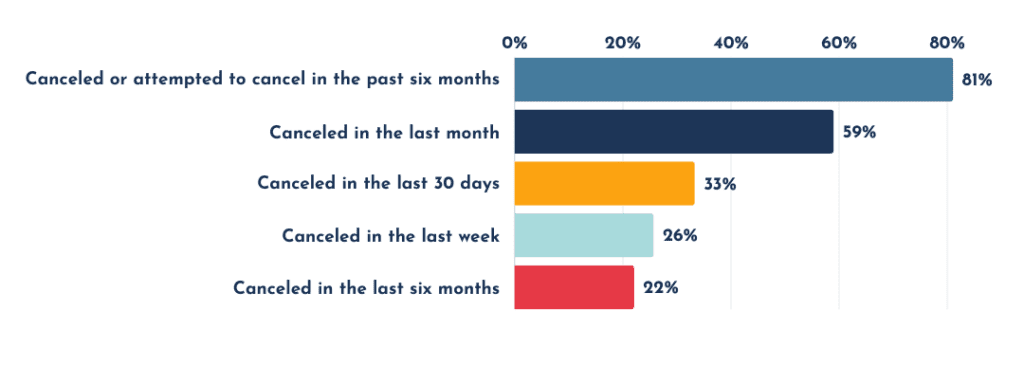
The high volume of cancellations offers businesses a chance to gather feedback, identify pain points, and implement winback strategies. Treating the cancellation process as an essential part of the customer journey can boost satisfaction, retention, and loyalty.
2. Duration of Customer Relationship
Our survey explored how long customers keep subscriptions before canceling, offering insights into retention. While 40.7% of respondents were customers for over 12 months, 23.6% canceled within 6-12 months, and 35.7% within the first 6 months.
These findings stress the need for businesses to consistently deliver value throughout the customer lifecycle. Early cancellations suggest issues with onboarding or perceived value, while later cancellations may reflect evolving customer needs or competition.
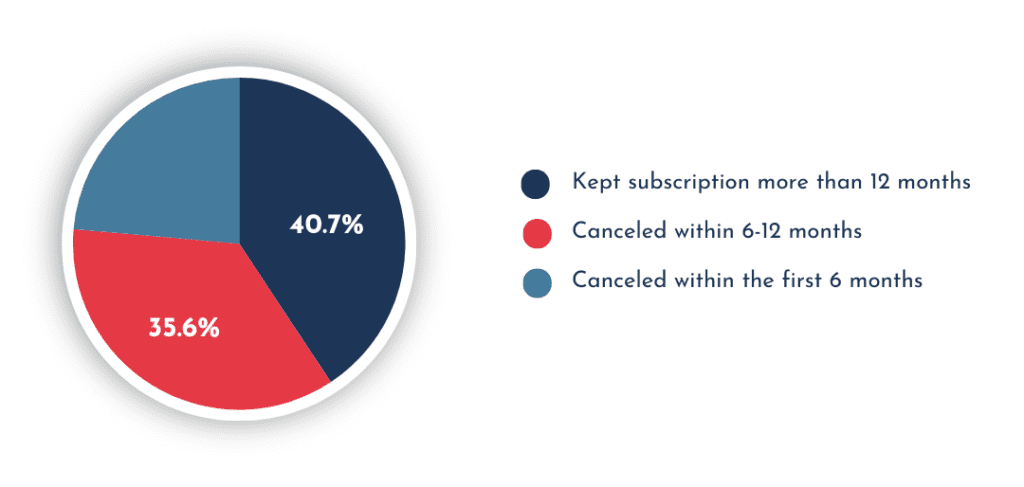
Targeted retention strategies at different stages can help improve customer lifetime value and reduce cancellation rates.
3. Primary Reasons for Cancellation
Cost was the top reason for cancellation, cited by 63% of respondents, emphasizing the importance of perceived value. Additionally, 57.8% canceled due to lack of usage or no longer needing the service.
Other reasons included dissatisfaction with content or service (15.4%), better alternatives (11%), and poor customer service (6.1%). Technical issues (2.7%) and privacy concerns (1.7%) were less common but noteworthy.

These findings highlight the need for brands to continuously demonstrate value, encourage regular usage, and reassess pricing strategies. Improving content, service offerings, and customer support can also help reduce cancellations and boost customer satisfaction.
4. Ease of Cancellation Experience
Only 23.6% of respondents found the cancellation process “Very easy,” while 34.3% rated it “Somewhat easy.” However, 28.9% encountered difficulties, with 22% finding it “Somewhat difficult” and 6.9% “Very difficult.”
These findings show that many businesses could improve their cancellation processes. Over a quarter of customers facing challenges can lead to frustration, harming brand perception and future re-subscription chances.
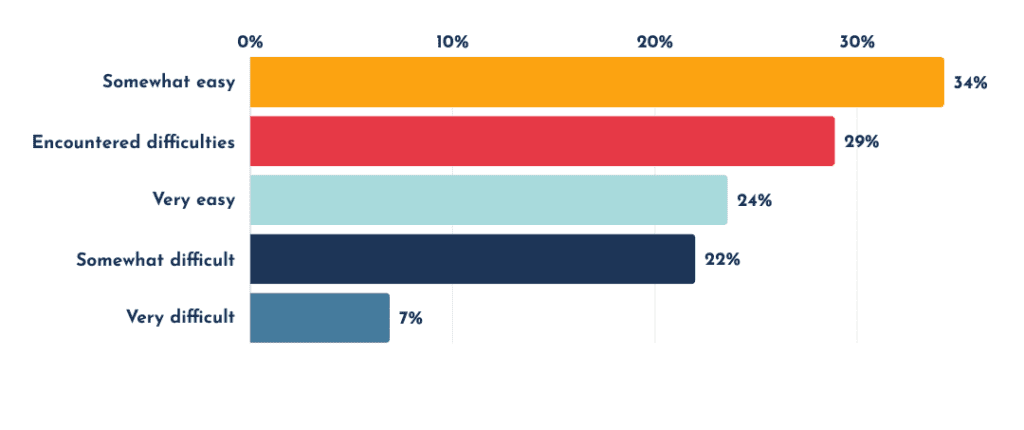
Streamlining cancellations is key. While retention is important, making the process too difficult can increase dissatisfaction. Clear, respectful cancellation options, along with feedback collection, can enhance customer satisfaction and brand reputation.
5. Challenges Encountered During Cancellation
The most common issue, cited by 40.8% of respondents, was difficulty finding cancellation options. Additionally, 31.7% had to contact customer service to cancel, and 28.9% felt pressured to stay subscribed.
Other challenges included a complicated multi-step process (24.3%), being forced to cancel through the subscription platform (10.9%), and automatic renewals despite cancellation attempts (10.7%). Technical issues affected 6.5%. However, 24.7% of respondents reported a smooth cancellation experience.
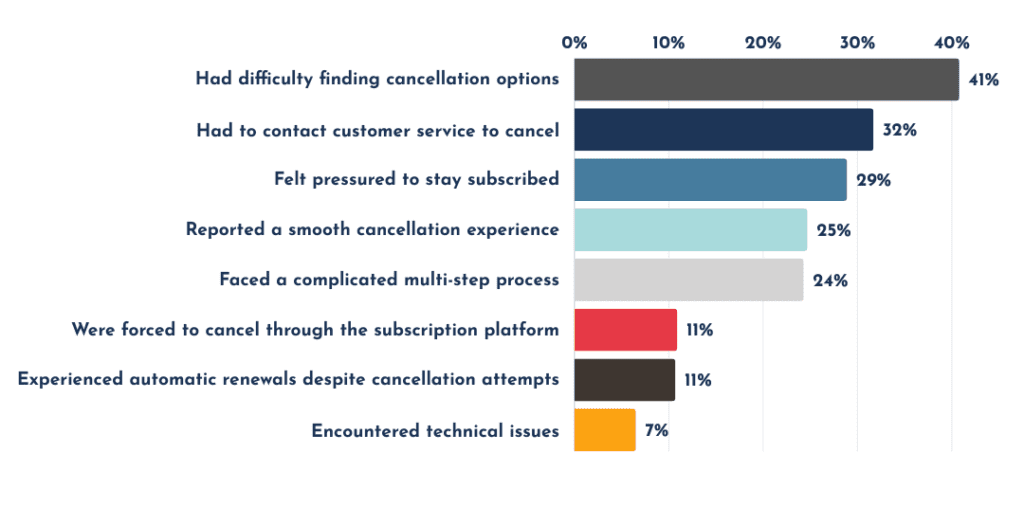
These findings suggest businesses should simplify cancellations, provide self-service options, and train customer service to handle cancellations respectfully. A positive experience can improve the likelihood of future reengagement and customer loyalty.
6. Special Incentives to Retain Subscriptions
Respondents reported receiving various incentives:

Notably, many respondents indicated that no incentive was offered. Some customers mentioned other types of incentives, including subscription flexibility and the option to downgrade to lower-priced levels.
These findings suggest that while some companies employ retention strategies, many may be missing opportunities to retain customers through targeted incentives. For businesses, this data highlights the importance of having a robust retention strategy that includes a variety of incentives tailored to different customer needs and preferences. Companies should consider developing a tiered approach to retention offers, potentially saving their most attractive incentives for their highest-value customers.
7. Downgrade Options During Cancellation
The majority of respondents (57.6%) reported that no other levels were mentioned when they attempted to cancel. 22.5% were already at the least expensive or free level. However, 16.5% were offered a less expensive option, and 3.4% were provided with a free option.

These results indicate that many businesses may be missing an opportunity to retain customers by not offering downgrade options. Providing less expensive or free alternatives could help companies maintain a relationship with customers who might otherwise be lost completely. For businesses, this suggests a potential strategy to reduce churn by implementing tiered pricing models and actively offering these options during the cancellation process.
8. Feedback Collection During Cancellation
A staggering 31.4% of respondents weren’t asked for feedback when canceling their subscription, meaning businesses miss out on valuable insights from nearly a third of their departing customers. Just over half (52.4%) were asked for feedback, while 16.2% couldn’t recall.
This lack of feedback collection is a missed opportunity. Without knowing why customers leave, businesses lose data that could improve products, pricing, or service, potentially leading to continued customer losses.

Implementing a simple, non-intrusive feedback process during cancellations can provide crucial data to improve retention strategies, refine services, and address pain points. In today’s competitive market, ignoring the voice of departing customers is a risk no business should take.
9. Preferred Cancellation Methods
A clear majority (68%) of respondents prefer to cancel directly through the service provider’s website or app. This overwhelming preference for self-service options highlights the importance of providing clear, easily accessible cancellation processes within the service’s own platforms.
Other preferences included:
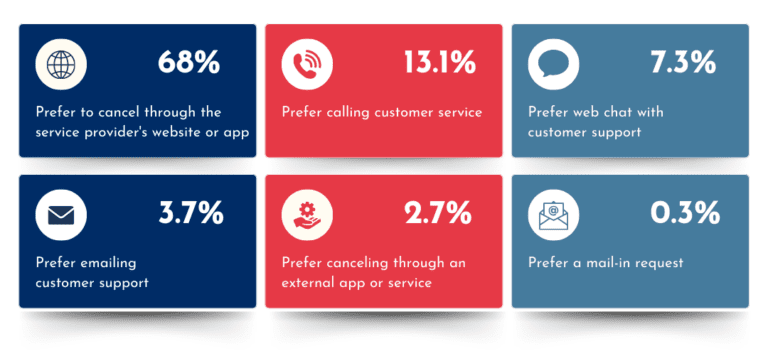
Businesses must prioritize user-friendly, self-service cancellation options on websites and apps, as most customers prefer managing subscriptions independently. While some still favor phone or chat, relying too heavily on these methods can frustrate users.
Investing in easy-to-use cancellation features can improve customer satisfaction, enhance win-back rates, and reduce negative effects on future acquisition. Treating cancellations as opportunities for feedback and re-engagement can turn this process into a valuable tool for customer relationship management and service improvement.
10. Impact on Future Decisions
60.43% of respondents have avoided signing up for a service because they heard canceling would be difficult, showing how poor cancellation experiences can hurt future customer acquisition.

These findings show that the cancellation process is critical yet often neglected. Improving cancellation procedures can boost customer satisfaction, increase win-back rates, and reduce negative impacts on future acquisition. This report offers insights for subscription businesses to improve their strategies. By treating cancellations as opportunities for feedback and re-engagement, companies can turn this process into a valuable tool for managing relationships and improving services.
Overall Cancellation Experiences
Respondents’ open-ended feedback revealed several common themes, illustrated by their own words:
- Difficulty Finding Cancellation Options: “It’s difficult to locate exactly how you go about doing it, many force you to call and speak with someone directly, who, then, have a script to attempt talking you out of it and even try to upsell you.”
- Preference for Online Cancellation: “I prefer to do it without having to contact anyone at all. Unfortunately, my mistrust of doing it myself through a site/app and getting it done right is too extreme.”
- Time-Consuming Processes: “You always have to spend another 15 mins after holding to try to cancel it but get stuck having to keep turning them down on other options. I wish they would just let me cancel the subscription with no questions asked.”
- Varied Experiences Across Services: “With the rise of technology, canceling has become easier. However, the most dreadful membership I had to cancel was the gym. It was a multistep process that required time and effort.”
- Post-Cancellation Issues: “Even after attempting to cancel a subscription, I was charged the next month. It took me to call Customer Service to ensure that the subscription was canceled successfully which is a major inconvenience of time.”
- Impact on Future Subscriptions: “Because of how difficult they make it to cancel, I avoid most subscriptions like the plague. I just use free versions and deal with the ads.”
- Positive Experiences: “I am way more likely to re-up a subscription at a later date if my experience with canceling is seamless. If I can’t cancel without any glitches, I am highly unlikely to re-subscribe.”
These experiences underscore the significant impact of the cancellation process on customer satisfaction and future purchasing decisions. Companies that streamline and improve their cancellation procedures can enhance overall customer experience and potentially increase the likelihood of future re-subscriptions.
Learning from Goodbyes: What Cancellations Teach Us
The landscape of subscription cancellations reveals a complex interplay between customer expectations and business practices:
- Cancellation frequency is high, with 81.1% of respondents canceling a subscription within the past six months.
- Cost and lack of usage are the primary drivers of cancellations, pointing to value perception issues.
- The cancellation process itself is often fraught with challenges, from difficulty finding cancellation options to pressure from customer service representatives.
- Poor cancellation experiences have far-reaching consequences, with 60.43% of respondents avoiding future subscriptions due to perceived cancellation difficulties.
- There’s a strong preference for self-service cancellation options, with 68% of customers preferring to cancel through a website or app.
Frequent cancellations offer both challenges and opportunities for businesses. While it signals customer dissatisfaction, it also presents a chance to address concerns and retain customers through flexible pricing and improved experiences.
A poor cancellation process can leave lasting negative impressions, deterring future engagements. Investments in easy, transparent self-service options can boost customer satisfaction, even during cancellations.
Viewing cancellations as a feedback opportunity allows businesses to improve, re-engage, and strengthen customer relationships.
Recommendations
Based on our findings, we recommend the following strategies for businesses to improve their cancellation processes:
- Streamline Self-Service Options: Develop user-friendly, easily accessible cancellation features within your website and app.
- Enhance Transparency: Clearly communicate cancellation policies and procedures at all stages of the customer journey.
- Implement Tiered Retention Strategies: Develop a range of incentives and downgrade options to retain customers considering cancellation.
- Prioritize Feedback Collection: Consistently gather and analyze feedback from canceling customers to identify areas for improvement.
- Train Customer Service Representatives: Ensure staff are equipped to handle cancellations respectfully and efficiently, without applying undue pressure.
- Optimize Post-Cancellation Processes: Ensure immediate cessation of charges and clear communication about the end of service to prevent post-cancellation issues.
- Consider Flexible Subscription Models: Offer pause options or more granular subscription levels to accommodate changing customer needs.
- Monitor and Benchmark: Regularly assess your cancellation process against industry best practices and competitor offerings.
Turn Cancellations into Opportunities
Are your competitors learning more from their cancellations than you are? Overlooking the insights from departing customers could be a costly mistake. Uncover the hidden value in cancellation data by measuring your brand’s cancellation experience.
Don’t let crucial feedback slip away — it could help reduce churn, improve customer satisfaction, and drive growth. Partner with A Closer Look to start turning customer goodbyes into opportunities for improvement and future success.